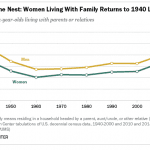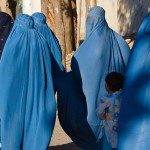Question 1: are women and girls required to wear a head-covering to attend prayers, or taught that it is a requirement of the faith? Are female schoolchildren and female teachers required to “cover” in their classes, and, if so, to what degree?
Question 2: are women and girls treated with equality when it comes to community prayer, either able to pray alongside the men, or in a similarly-appointed area with prayer leaders who pray alongside them?
Question 3: when Barack Obama visits this mosque on Wednesday, will women be in attendence, in the same room as the men, and offered the option to cover or stay uncovered, as they wish?
I raise this because this mosque has now made the news for being the first mosque in the United States to be visited by President Obama, and various conservative news sites are raising questions as to the mosque’s extremist ties, such as this article in the Daily Caller, and this one at Breitbart. If you look at their website, they seem moderate enough, for example, based on this self-description:
The Islamic Society of Baltimore aspires to be the anchor of a growing Muslim community with diverse backgrounds, democratically governed, relating to one another with inclusiveness and tolerance, and interacting with neighbors in an Islamic exemplary manner. Maryland’s largest Islamic community with full-time K-12 school, Quran Academy, Community Health Clinic, Nursery, and more. ISB engages in regular interfaith, government relations, social services, and much more!
But what about their deeds, not just their words?
Here’s a view of their women’s prayer space, as of 2010. No accompanying text, but the drop ceiling makes it pretty clear that women are confined to the basement.
What about their school dress code? Regular readers will recall that I looked through dress codes of Islamic schools that popped up in a google search, and found that they quite cosistently required a hijab or even a full abaya for girls. As for ISB, well, their school’s handbook isn’t available online (the site says it’s being updated), so there isn’t much to go on except poring through the photos on the site, which do feature head-covered girls, but at least one perhaps older elementary-school aged girl without one. There’s an extended gallery here, which show girls predominently wearing headcoverings of various kinds (even one girl covering her face for the camera), but a few without, though it does seem that once the girls leave elementary school for middle and high school, a hijab and abaya are mandatory. It also appears, based on their January newsletter, that they segregate the classes by sex as early beginning in the third grade.
Of course, it’s wishful thinking to imagine that Obama would choose for his mosque visit a place that allowed women and girls free choice as to how to dress, and treated them with equality when it comes to worship. And as for exactly what transpires on Wednesday, well, we’ll have to wait and see, won’t we?
UPDATE:
The Muslim Reform Movement (Twitter handle @TheMuslimReform) is holding a protest at this mosque. From their Facebook page:
Please join us at a polite “Pray-In Protest,” advocating for women’s rights at mosques, TODAY, WED, FEB 3, 11:30 AM, at the Islamic Society of Baltimore, 6631 Johnnycake Road, WINDSOR MILL, MD., where President Obama will have his first mosque visit in the U.S. Contact us at (202) 798-1786.
Like two out of three mosques in the U.S., this mosque practices gender segregation that amounts to separate and unequal conditions. On Sunday, girls prayed in the gym, facing an industrial wall, instead of the prayer hall where boys prayed. We will be standing up for women’s rights at mosques, as a symbol of broader rights in education, voice and work.
WHERE: Islamic Society of Baltimore, 6631 Johnnycake Road, Windsor Mill, Road, 21244
WHEN: Wednesday, FEB 3, 2016, President Obama is scheduled to visit the mosque at about 12 PM. Please arrive as close to 11:30 AM as you can.
CONTACT: To find our location, please call Asra Nomani, Ify Okoye, Fatima Thompson at (202) 798-1786. We’ll keep you updated here, as well, as to our location and status.
For over a decade, many of us have been fighting in the trenches for women’s rights in mosques. It was a shock to us that President Obama chose to go to the Islamic Society of Baltimore, a mosque notorious among Muslim women activists for its gender inequity in its prayer space. Mosque officials insist that it doesn’t have a policy “preventing” women from the sun-drenched main hall, filled with books, where President Obama will hold his mosque photo-op. But what we witnessed this past Sunday was very separate and unequal conditions, girls being dispatched to the gym to pray, while boys prayed in the main hall where President Obama will stand.
Please join us in loving spirit — either in body or in long-distance support.#MuslimReform#PrayIn#MyStealthyFreedom
And please follow us @TheMuslimReform for updates
The New York Times has also published an opinion piece (at least online) by Muslim activists, “Obama’s mosque visit demonstrates tacit acceptance of a form of gender apartheid” (link from Breitbart):
President Obama should be aware that on any given day a woman or girl worshiping in the mosque would be dispatched away from the musallah where he will stand to speak out against “Islamophobia,” to the “prayer room for females,” as one worshipper described it. In much the same way that he wants to mitigate Americans seeing Muslims as the “other,” we have to challenge the Muslim systems that segregate women as the “other.” He should know that promoting women’s rights in mosques is a key part of fighting the ideology of extremism — a fight that he asked American Muslims to help wage in an address to the nation in December. A theology of Islamic feminism is our best answer to the extremism of ISIS, al-Qaeda and other Muslim militant groups. Even the most conservative of Islamic scholars acknowledge that, in the 7th century, the sunnah, or tradition of the prophet Muhammad, was to allow women to pray in the main hall of his mosque in Medina without any barrier in front of them. . . .
Today, in an estimated two-thirds of mosques around the United States, women and girls are segregated in dark basements, sparse balconies, separate rooms and even behind shower curtains in the “sisters’ section,” listening to Friday sermons piped in through shaky sound systems and watching them, if we are lucky, via TV screens. It’s too often only on “interfaith” occasions like the president’s visit that women and girls get to step forward into the “brothers’ section.”













